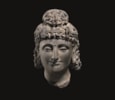Magnificent Head Of Maitreya, Buddha
This spectacularly beautiful head of the Bodhisattva Maitreya, the Buddha of the Future, was carved from one of the finest types of schist in Gandhara in the region of modern Northwest-Pakistan. It is very likely, that the head once was part of a standing sculpture of Maitreya; unfortunately, it broke off from that very sculpture in Antiquity. The face shows Maitreya as a young prince and combines the classical Greek-Roman artistic taste for a head of a young man with the sensuous refinement of Indian religious spirit. The nose is aquiline and straight, and follow the lines of the eyebrows. The eyes are open, the lips are relatively small and closed, but show a sensuous smile. The iconographic sign of enlightenment, called `urna´ in Sanskrit was set between the eyebrows. The hairdo is styled extremely fine; the long-curled hair falls down to the neck. The upper part of the hair is shown as a prominent knot on top of the head, called `ushnisha´ in the religious nomenclature of Buddhism. All tufts of the curled hair are finely arranged under a combination of a diadem and kind of hairnet, designed of double rows of pearls. It seems as if two cockades fasten the diadem-like hairnet in front of the hairdo. The ears of Maitrya are elongated and once showed two earrings; unfortunately, only the left ear´s earring has survived. The earring of the left ear is designed in form of a rounded, basket-like bead with a mixture of pearled and vertical, straight-line patterns. The Gandharan Maitrya head discussed here is one of the finest and most magnificent Gandharan artworks of this very type, only comparable to similarly finest examples of this type, like to a schist head of Maitreya from Palatu Dheri, now in the Peshawar Museum Pakistan (Ingholt and Islay 1957), one Maitreya-head in the Bombay Museum, followed by the head of a Maitreya-statue in the Lahore Museum Pakistan (Tissot 1986). Of the same exceptional quality and refinement are a head in the Russek-Collection in Switzerland (Russek 1987), one more head in the Musee Guimet in Paris, France (Gies and Cohen 1995), as well as a similarly wonderful head in the Royal Ontario Museum Toronto, Canada (Jongeward 2003) , and- last but not least!- the head of a magnificent head of a standing Maitreya from Gandhara in the Norton Simon Museum in Pasadena, California, USA (Pal 2003). This Gandharan schist-head of a Bodhisattva Maitreya must be dated to the 3rd century AD / CE, and should be valued as one of the finest in quality known from international museum-collections worldwide.
Sotheby & Co., London, 12th December 1960, lot 62
‘The Burlington Magazine’ December 1960. Sotheby’s Advert.
David Aaron Ltd, 2020, No. 20.
Previously in the Private Collection of the Honourable John Edward Bingham of Sussex, England (1904–1992)
Sold at: Sotheby & Co., London, 12th December 1960, lot 62
With A. Garebed (1923-1958), London
Private Collection of Denys Miller Sutton (1917–1991), UK
Thence by descent to his wife Cynthia Sassoon in 1991
Thence by descent
New York Art Market, 2013
With David Aaron Ltd, London.
Private Collection, UK
Hon. John Bingham lived in Sussex, England. He was a collector of Gandharan sculpture and published a book on his collection in 1954 (mentioned in the original Sotheby's catalogue ).
Denys Miller Sutton 1917 – 1991) was a British art critic and historian known for his focus on European artists before 1800 (Old Masters) and Asian art. He was the art critic for the Financial Times and editor of Apollo magazine.










 Enquire
Enquire




